New Pentagon Initiative Aims to Help Allies, Contractors Work Together on AI

Secretary of Defense Mark Esper records statement for virtual A.I. Symposium in the Pentagon Briefing Room Sept. 8. Marvin Lynchard/Defense Department
New tools are planned to help various militaries and defense companies cooperate and interoperate on artificial intelligence.
To better compete with China and Russia in developing artificial intelligence, the Defense Department will launch a new partnership with defense organizations from more than 10 nations, with more expected to join over the coming year, Defense Secretary Mark Esper announced on Wednesday.
The AI Partnership for Defense will “create new frameworks and tools for data sharing, cooperative development, and strengthened interoperability” across partner militaries, Esper said at the Joint Artificial Intelligence Center’s Symposium. It will also help embed awareness and understanding of AI into contracting and training for personnel working in areas that include AI.
More details, including which nations will initially join the partnership, will become available next week, a Defense Department senior official said on background.
Esper said the Pentagon’s approach to AI development is more grounded in democratic values than those of China and Russia. “We are pioneering a vision for emerging technology that protects the U.S. Constitution and the sacred rights of all Americans. Abroad, we seek to promote the adoption of AI in a manner consistent with the values we share with our allies and partners: individual liberty, democracy, human rights, and respect for the rule of law, to name a few,” he said.
China and Russia, meanwhile, are pursuing strikingly different courses, Esper said. China is building a “21st-century surveillance state,” he said, borrowing a term he first used in January to describe Beijing’s use of facial recognition and other machine-learning tools to monitor and mistreat the Uyghur Muslim population in Xinjiang and ipro-democracy dissidents in Hong Kong. “Moreover, As China scales this technology, we fully expect it to sell these capabilities abroad, enabling other autocratic governments to move toward a new era of digital authoritarianism,” he said.
On Russia, Esper highlighted advances in “autonomous systems across ground vehicles, aircraft, nuclear submarines, and command and control. We expect them to deploy these capabilities in future combat zones.”
He said Russia has been trying out AI-and-autonomy-enabled command-and-control schemes since 2014, “when Russian forces used a sophisticated and well-coordinated combination of unmanned aerial vehicles, cyberattacks, and artillery barrage to inflict severe damage on Ukrainian forces.” His description sounds a lot like the Joint All Domain Command and Control networked-warfare concept that the Defense Department has been pursuing in recent years.
Esper said that the Center would work with the Defense Acquisition University and the Naval Postgraduate School to launch a pilot course in October to train “over 80 defense acquisition professionals of all ranks and grades” on data science and bringing AI and AI skills into operations. “With the support of Congress, the Department plans to request additional funding for the Services,” he said.
The JAIC has also launched a nine-week training course for personnel working directly on AI. “We plan to scale this program to all DoD components over the coming year,” he said.
Finally, Esper noted the Department’s list of AI principles, which affects how AI is built, trained, tested, and deployed. Google and Facebook have adopted similar, less-detailed lists. Defense Department leaders hope that writing and implementing the list will reassure nervous Silicon Valley partners and touchy European allies that they can work with the U.S. military on next-generation capabilities (though not necessarily weapons). “These principles make clear to the American people – and the world – that the United States will once again lead the way in the responsible development and application of emerging technologies, reinforcing our role as the global security partner of choice,” he said.
Martijn Rasser, a senior fellow at the Center for New American Security, applauded the move. “One of the most important things for the United States to do in this era of strategic competition is shaping global norms and values for technology use. This is best done in concert with like-minded countries, especially U.S. allies,” Rasser said in an email. “While there are different approaches to technology use that may pose some initial challenges to implementation, shared respect for democratic norms and values provide the essential foundation to overcome those hurdles and achieve broad-based collaboration in this area.”
Peter Singer, a strategist and senior fellow at the New America Foundation, said the success of that outreach will depend on how well the Defense Department differentiates what it’s doing from China and Russia. “If there is an ‘AI arms race,’ it isn't a Cold War-style race to develop the best and most of a technology that only a few players have,” wrote Singer, most whose most recent book is the AI-themed novel Burn In. “Rather, it is about fundamentally different competing visions of AI and its applications, not just in war, but across society. China has a fairly clear and robust vision of this, and it is actively exporting that vision. There is absolutely no way the U.S. can compete without offering a different and compelling vision and one that involves our friends and allies.”



